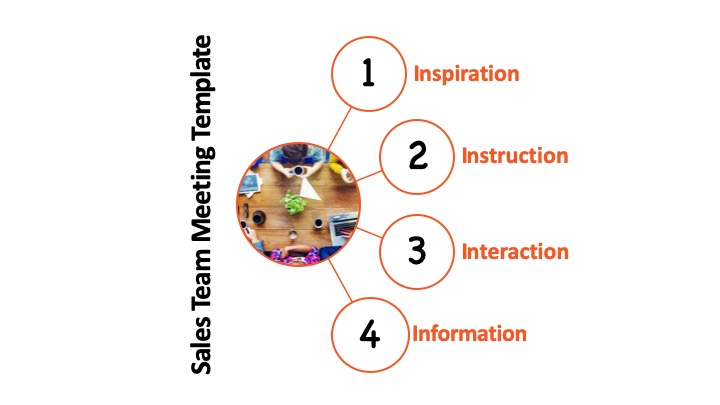Let me brutally honest with you. Salespeople hate going to meetings. There, I’ve said it. Here’s why.
First, salespeople are action-oriented. They don’t like sitting in meetings. It’s not in their DNA. For most of your sellers, school was a painful experience for this very reason, and your sales team meetings remind them of being in school.
And second, salespeople receive compensation from engaging in sales activity, not from sitting in a sales team meeting. Every minute in a meeting is a minute that keeps them from making money.
The great irony about sales team meetings is this: they have the amazing potential to transform your team. When done right, they can light the fire of passion within your sellers’ soul and fan that flame into a raging fire.
Here’s how to make your sales team meetings matter again, or, perhaps, matter for the very first time.
A Four-Part Sales Team Meeting Template
Sales team meetings that matter don’t happen by accident. They take planning and persistence. Well-planned sales team meetings have four key elements to them: inspiration, instruction, interaction, and information.
1. Inspiration
Selling is hard work. If it wasn’t, everyone would be a successful salesperson. Everyone most certainly is not a successful salesperson. Sales is like riding a bicycle uphill with the wind in your face, all day, every day. Crazy thing is, most of the salespeople I know are fine with that. They love the challenge of the climb and wouldn’t want to live their life any other way.
Here’s what they don’t want. They don’t want the captain of their cycling team adding to that challenge. While they’re working hard riding uphill with the wind in their face, they don’t want their manager cruising in a car next to them criticizing their form for the whole world to hear. In fact, they want just the opposite: words of encouragement that get them to the front of the pack.
The leadership adage, praise in public and correct in private, applies here in spades. Rarely is public correction in a sales meeting effective. That kind of slap in the face is humiliating and demotivating. Just the opposite, however, is energizing and inspiring: public recognition and reward. Begin every team meeting by amping up its emotional tone with the power of positive praise.
Tell the story of a recent sales success with a rep in the room as the hero of that story. Give out gift cards to everyone who’s completed a certain number of outbound calls that resulted in a new appointment and cheer for each person as he or she comes to the front of the room to get their card. Celebrate birthdays, work anniversaries, new logos, won deals, whatever. Be inspiring!

2. Instruction
Not only is selling hard work, it’s complicated work as well. Like golf, there’s always something new to learn, always something else to work on. The minute you think driving off the tee is going well, you’ve got to work on your short game. The round where your fairway irons hit every green is the same round where you three-putt ten times. There’s always something!
I hate golf, but I love sales because of the life-long learning opportunities it provides. Embrace this dynamic in all your sales team meetings. From a ten minute tip to all day training, teach your sellers how to sell even better than they do already.
Just make sure to vet any instruction you provide. All sales are not the same. If your sales process has one decision maker and requires one call to close, find training that teaches your sellers how to quickly connect with prospects and direct discussions to a done deal. If, however, your sales process has a committee of decision makers and takes eighteen months to close, the training you provide should teach something totally different.
Know what your sellers need to be the very best at what they do and give it to them week after week after week.
3. Interaction
The third part of my template for every sales team meeting, interaction, recognizes that salespeople are kinesthetic.
What in the world does that mean?
Kinesthetic refers to a learning style that learns by doing. Auditory learners learn by hearing, but most adults—and most salespeople for that matter—aren’t auditory learners. They’re kinesthetic learners and need information presented in an interactive environment that allows to fully participate in the process.
Set aside one-way communication, or keep it to a bare minimum, and use discussion groups, games, contests, role plays, and learning exercises. This isn’t fluff, and don’t let anyone tell you that it is. It’s wise recognition that kinesthetic learners need active engagement to understand and apply any content that’s being presented to them.
There’s another important reason to conduct interactive team meetings. Your salespeople are on the frontline of the marketplace. They’re seeing things that no one else in your company is seeing, and they’re experiencing things that no one else in your company is experiencing. Interaction takes the time to talk with them about the pulse of the marketplace.
It was a salesperson who alerted Intel in 1979 that Motorola had developed a faster, easier to program microprocessor and was killing them in the marketplace. Intel’s President and Chief Operating Officer, the legendary Andy Grove, listened to that salesperson, and the rest is history.
MORE: Stop! Before You Lead Your Next Meeting Ask These Four Questions
4. Information
Okay, now it’s time for you to talk. Sharing information is last in the sales team meeting template not because it’s the least important, but because inspiration, instruction, and interaction set the table for it. When you, in the words of Steven Covey, “seek first to understand, then to be understood,” you’ll find things that usually get ignored are more positively received by your team.
This is the time to communicate corporate developments and coordinate the company calendar. This is also the time to share information on progress toward goal, product changes, and pricing details.
If you work in a larger organization, there will be immense pressure to make this the most extensive part of your meeting. The reality of corporate life is that information expands to fill the time given it (and then some). Resist this pressure to make your team meetings a dumping ground for cooperate dictums. Review stuff at a high level, follow-up with email, and use technology, like HighSpot or Slack, to do the heavy lifting for you.
Inspiration, instruction, interaction, and information, like the four walls of a building, the four tires of a car, the four legs on a table—insert your favorite metaphor here—are critical keys to effective sales team meetings. Apply them rigorously to every gathering of your group and watch you sales soar as a result.


